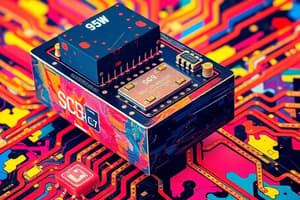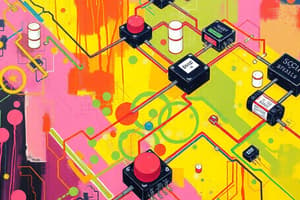Podcast
Questions and Answers
What is a primary advantage of Silicon Controlled Rectifiers compared to normal diodes?
What is a primary advantage of Silicon Controlled Rectifiers compared to normal diodes?
- SCRs are made up of two semiconductor layers.
- SCRs allow electric current in both directions.
- SCRs are capable of withstanding high voltages. (correct)
- SCRs can operate at low voltages.
What is the structure of a Silicon Controlled Rectifier?
What is the structure of a Silicon Controlled Rectifier?
- Two layers of alternating P and N type material.
- Four layers of alternating P and N type material. (correct)
- A single layer of N type material.
- Three layers of P type material.
In which application are Silicon Controlled Rectifiers primarily utilized?
In which application are Silicon Controlled Rectifiers primarily utilized?
- Converting AC to high frequency electricity.
- Storing electrical energy in batteries.
- Controlling power delivered to electric motors. (correct)
- Amplifying small signals in radio equipment.
Who were the primary developers of the principle of p-n-p-n switching, which is fundamental to SCRs?
Who were the primary developers of the principle of p-n-p-n switching, which is fundamental to SCRs?
What term is often used to refer to the Silicon Controlled Rectifier now?
What term is often used to refer to the Silicon Controlled Rectifier now?
What terminals does a Silicon Controlled Rectifier (SCR) have?
What terminals does a Silicon Controlled Rectifier (SCR) have?
In which mode of operation does the SCR remain in an off state while being forward biased?
In which mode of operation does the SCR remain in an off state while being forward biased?
What occurs when the voltage applied to an SCR reaches the breakdown value?
What occurs when the voltage applied to an SCR reaches the breakdown value?
What happens to the depletion region at junction J2 when a positive voltage is applied to the gate terminal?
What happens to the depletion region at junction J2 when a positive voltage is applied to the gate terminal?
Which of the following describes the Reverse Blocking Mode of an SCR?
Which of the following describes the Reverse Blocking Mode of an SCR?
What happens to the junctions of an SCR in the forward blocking region?
What happens to the junctions of an SCR in the forward blocking region?
In the forward conduction region of an SCR's V-I characteristics, what occurs when the forward bias voltage exceeds the breakdown voltage?
In the forward conduction region of an SCR's V-I characteristics, what occurs when the forward bias voltage exceeds the breakdown voltage?
What defines the reverse avalanche region in SCR operation?
What defines the reverse avalanche region in SCR operation?
How many terminals does a TRIAC have, and what is its primary function?
How many terminals does a TRIAC have, and what is its primary function?
Which condition allows a TRIAC to conduct when MT2 is at positive potential with respect to MT1 and gate potential is negative?
Which condition allows a TRIAC to conduct when MT2 is at positive potential with respect to MT1 and gate potential is negative?
What characterizes Mode 2 operation in a TRIAC?
What characterizes Mode 2 operation in a TRIAC?
What is the purpose of the external resistance in a TRIAC circuit?
What is the purpose of the external resistance in a TRIAC circuit?
Which of the following is NOT an advantage of using a TRIAC?
Which of the following is NOT an advantage of using a TRIAC?
What does a DIAC primarily trigger?
What does a DIAC primarily trigger?
What structural characteristic does a 5-layer DIAC have?
What structural characteristic does a 5-layer DIAC have?
What happens when the applied voltage across a DIAC exceeds its break over voltage?
What happens when the applied voltage across a DIAC exceeds its break over voltage?
In which quadrants does a DIAC operate according to its V-I characteristics?
In which quadrants does a DIAC operate according to its V-I characteristics?
What occurs at junction J2 when the SCR reaches the forward break over voltage during the forward voltage triggering method?
What occurs at junction J2 when the SCR reaches the forward break over voltage during the forward voltage triggering method?
Which method is the most reliable and commonly used for turning ON an SCR?
Which method is the most reliable and commonly used for turning ON an SCR?
What happens to the leakage current in an SCR as the temperature increases during thermal triggering?
What happens to the leakage current in an SCR as the temperature increases during thermal triggering?
Which of the following provides a transient gate current sufficient to turn ON the SCR during dV/dt triggering?
Which of the following provides a transient gate current sufficient to turn ON the SCR during dV/dt triggering?
What is a major drawback of using DC triggering for turning ON an SCR?
What is a major drawback of using DC triggering for turning ON an SCR?
How does the structure of a light-activated SCR (LASCR) facilitate its operation?
How does the structure of a light-activated SCR (LASCR) facilitate its operation?
In which mode is the SCR when the gate terminal is open and the anode is positive with respect to the cathode?
In which mode is the SCR when the gate terminal is open and the anode is positive with respect to the cathode?
What is a significant advantage of using a DIAC in a circuit?
What is a significant advantage of using a DIAC in a circuit?
What is a potential consequence of continuously using forward voltage triggering for the SCR?
What is a potential consequence of continuously using forward voltage triggering for the SCR?
What happens to junctions J1 and J3 during the forward blocking mode?
What happens to junctions J1 and J3 during the forward blocking mode?
What is the primary application of a DIAC?
What is the primary application of a DIAC?
Which scenario indicates that an SCR is conducting?
Which scenario indicates that an SCR is conducting?
Which of the following statements correctly describes the turn-on mechanism of an SCR?
Which of the following statements correctly describes the turn-on mechanism of an SCR?
What characterizes the two transistor analogy of an SCR?
What characterizes the two transistor analogy of an SCR?
Which condition must be met for a DIAC to start conducting?
Which condition must be met for a DIAC to start conducting?
Why is the SCR labeled as a low power device?
Why is the SCR labeled as a low power device?
What does symmetrical switching in a DIAC help reduce?
What does symmetrical switching in a DIAC help reduce?
In relation to the SCR's turn-on mechanism, what occurs after the gate triggering signal is applied?
In relation to the SCR's turn-on mechanism, what occurs after the gate triggering signal is applied?
Flashcards
SCR (Silicon Controlled Rectifier)
SCR (Silicon Controlled Rectifier)
A 3-terminal, 4-layer semiconductor device used to control high power, converting AC to DC.
SCR diode and 4-layer diode
SCR diode and 4-layer diode
Other names for a Silicon Controlled Rectifier, highlighting its multi-layer structure.
Thyristor
Thyristor
Another common name for an SCR, now often used more commonly.
High-power applications of SCR
High-power applications of SCR
Signup and view all the flashcards
4-layer structure of SCR
4-layer structure of SCR
Signup and view all the flashcards
SCR Symbol
SCR Symbol
Signup and view all the flashcards
Forward Blocking Mode
Forward Blocking Mode
Signup and view all the flashcards
Forward Conducting Mode
Forward Conducting Mode
Signup and view all the flashcards
Reverse Blocking Mode
Reverse Blocking Mode
Signup and view all the flashcards
SCR Construction
SCR Construction
Signup and view all the flashcards
SCR Forward Blocking Region
SCR Forward Blocking Region
Signup and view all the flashcards
SCR Forward Conduction Region
SCR Forward Conduction Region
Signup and view all the flashcards
SCR Reverse Blocking Region
SCR Reverse Blocking Region
Signup and view all the flashcards
TRIAC Operation
TRIAC Operation
Signup and view all the flashcards
TRIAC Modes
TRIAC Modes
Signup and view all the flashcards
TRIAC Operation Modes
TRIAC Operation Modes
Signup and view all the flashcards
TRIAC On-State Current
TRIAC On-State Current
Signup and view all the flashcards
DIAC Triggering
DIAC Triggering
Signup and view all the flashcards
DIAC 'Z' Characteristics
DIAC 'Z' Characteristics
Signup and view all the flashcards
TRIAC Control Circuit
TRIAC Control Circuit
Signup and view all the flashcards
DIAC Construction
DIAC Construction
Signup and view all the flashcards
DIAC Holding Current
DIAC Holding Current
Signup and view all the flashcards
DIAC Advantages
DIAC Advantages
Signup and view all the flashcards
DIAC Disadvantages
DIAC Disadvantages
Signup and view all the flashcards
DIAC Application
DIAC Application
Signup and view all the flashcards
Two Transistor Analogy of SCR
Two Transistor Analogy of SCR
Signup and view all the flashcards
SCR Turn-On Mechanism
SCR Turn-On Mechanism
Signup and view all the flashcards
Forward Biasing (SCR)
Forward Biasing (SCR)
Signup and view all the flashcards
Gate Triggering Signal
Gate Triggering Signal
Signup and view all the flashcards
SCR Holding Current
SCR Holding Current
Signup and view all the flashcards
Symmetrical Switching Characteristics
Symmetrical Switching Characteristics
Signup and view all the flashcards
Forward Voltage Triggering
Forward Voltage Triggering
Signup and view all the flashcards
Light Triggering (LASCR)
Light Triggering (LASCR)
Signup and view all the flashcards
Temperature Triggering
Temperature Triggering
Signup and view all the flashcards
dV/dt Triggering
dV/dt Triggering
Signup and view all the flashcards
Gate Triggering (Reliable Method)
Gate Triggering (Reliable Method)
Signup and view all the flashcards
Forward Blocking Mode
Forward Blocking Mode
Signup and view all the flashcards
Forward Conducting Mode
Forward Conducting Mode
Signup and view all the flashcards
Reverse Blocking Mode
Reverse Blocking Mode
Signup and view all the flashcards
Gate Triggering
Gate Triggering
Signup and view all the flashcards





